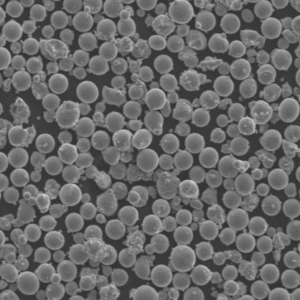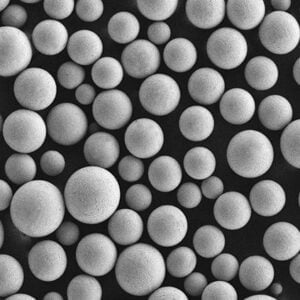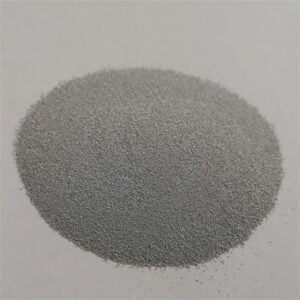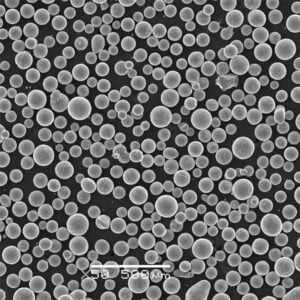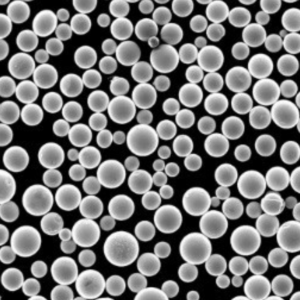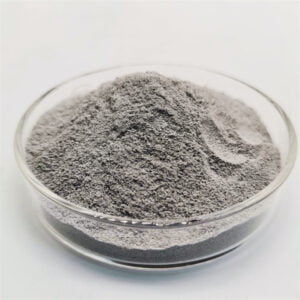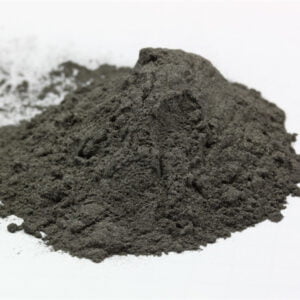金属合金粉末
目次
金属合金粉末 は、高度な製造技術に理想的な微細な球状粒子に噴霧化処理された金属元素の多様で精密なブレンドから構成されています。このガイドブックは、典型的な組成、機械的特性データ、製造方法、主要用途、および主要なグローバルサプライヤーにまたがる金属粉末合金グレードに関する包括的なリファレンスを技術専門家に提供します。
金属合金粉末の概要
鉄、ニッケル、コバルト、アルミニウム、チタン、銅、およびその他の卑金属の合金から製造される金属粉末は、その制御された組成から調整された特性を付与する汎用性の高いエンジニアリング材料である。
一般的な金属粉末の種類
| 合金システム | 説明 |
|---|---|
| ステンレス鋼 | 耐食性、高強度 |
| 工具鋼および低合金鋼 | 硬化、温度耐性 |
| ニッケル超合金 | 耐熱性/耐薬品性 |
| コバルト超合金 | 生体適合性、耐摩耗性 |
| チタン合金 | 軽量で航空宇宙用に強い |
| 銅とブロンズ | 電気・熱伝導率 |
| 貴金属合金 | 純粋、不活性、特殊用途 |
成分のバランスをとることで、硬度、強度、耐久性、導電性、磁性、コスト目標などの主要な要件に最適化することができる。
代表的な組成範囲
| 合金元素 | 役割 | Wt% レンジ |
|---|---|---|
| 鉄、コバルト、ニッケル | 母材 | 50-99% |
| クロム | 耐食性+耐酸化性 | 5-35% |
| モリブデン | 強度、耐クリープ性 | 0-30% |
| タングステン | 耐熱性、密度 | 0-18% |
| マンガン | 脱酸素剤、強度 | 0-15% |
| カーボン | 硬化性、耐摩耗性 | 0-6% |
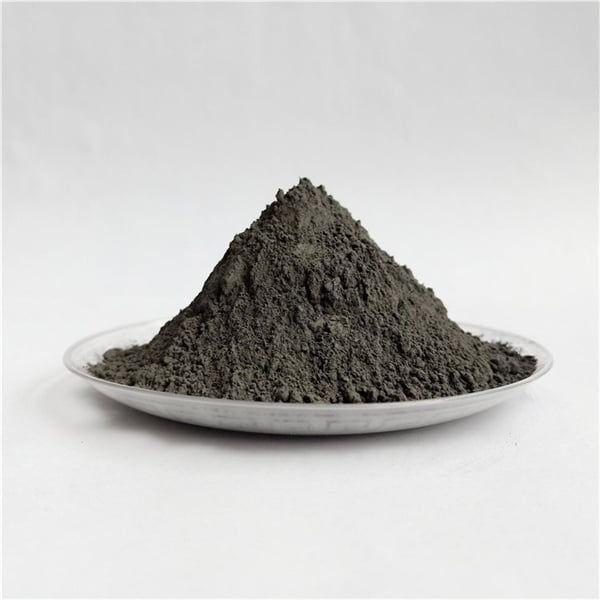
メタル合金パウダー 仕様
サイズ分布
| メッシュサイズ | マイクロメーター |
|---|---|
| -325 | <45 μm |
| -100/+325 | 45-150 μm |
| +100 | >150 μm |
モルフォロジーとフロー特性
| 属性 | 典型的な範囲 |
|---|---|
| 粒子形状 | 球形 |
| 見かけ密度 | 2 - 6 g/cm3 |
| タップ密度 | 4 - 8 g/cm3 |
| ハウスナー比 | <1.25 |
| 流量 | 20~35秒/50g |
| 摩擦係数 | 0.4-0.9 |
化学と汚染レベル
| エレメント | 最大ppm |
|---|---|
| 酸素 | 1000 |
| 窒素 | 150 |
| カーボン | 3000 |
| 硫黄 | 100 |
金属粉末の製造方法
水の霧化
- 高純度不活性ガス噴霧
- 反応性合金化学物質を保護
- 小さなサイズ分布が可能
ガス噴霧
- エアメルト・スピニング
- 最も狭いサイズ分布
- 球状粒子形状
プラズマ回転電極プロセス(PREP)
- カスタム合金、研究量
- 制御された微細構造
- 迅速な凝固速度
機械的合金化
- ボールミルによる元素混合
- 霧化よりも低コスト
- 幅広いサイズ分布
その他の方法
- 電解
- 化学還元
金属合金粉末の特性
主要な属性のバランスを取ることで、適切な用途が決まる:
機械的特性
| 合金システム | 降伏強度 | 引張強度 | 伸び |
|---|---|---|---|
| ステンレス鋼 | 200-1400 MPa | 500-1600 MPa | 10-50% |
| 工具鋼 | 600~1900 MPa | 1000-2100 MPa | 5-15% |
| ニッケル超合金 | 500-1400 MPa | 700~1700 MPa | 10-50% |
| チタン合金 | 750-1100 MPa | 900~1200MPa | 15-25% |
| 銅/ブロンズ | 70-450 MPa | 200-600 MPa | 5-60% |
熱特性
| 合金システム | 融点 | 熱伝導率 |
|---|---|---|
| ステンレス鋼 | 1400-1500°C | 10-30 W/m-°K |
| 工具鋼 | 1350-1450°C | 20-35 W/m-°K |
| ニッケル超合金 | 1200-1400°C | 5-50 W/m-°K |
| チタン合金 | 1600-1700°C | 5-20 W/m-°K |
| 銅/ブロンズ | 900-1300°C | 50-400 W/m-°K |
金属合金粉末の用途
アディティブ・マニュファクチャリング
- 航空宇宙部品
- 医療用インプラント
- 自動車用ハードウェア
- 金型
- エキゾチックな建築
粉末冶金
- オイル&ガス・ベアリング
- 自動車用ブッシュ
- アプライアンス・ハードウェア
- 費用対効果の高いネットシェイプ
溶射コーティング
- 耐腐食性オーバーレイ
- 摩擦低減フィルム
- 寸法復元
電子工学と磁気学
- 導電性接着剤
- インダクターコア
- 熱管理
- 表面実装デバイス
新たなアプリケーション
- 電池とエネルギー貯蔵
- 3Dプリンテッドエレクトロニクス
- エキゾチック合金とプロトタイプ
- マイクロスケール部品
リーディング メタル合金パウダー メーカー
| 会社概要 | 所在地 |
|---|---|
| サンドビック・オスプレイ | イギリス |
| カーペンター・パウダー製品 | 米国 |
| プラクセア・サーフェス・テクノロジー | 米国 |
| ヘガネス | スウェーデン |
| リオ・ティント・メタル・パウダーズ | カナダ |
| ATI粉末冶金 | 米国 |
カスタム料金処理パートナー
- 豊富な合金開発の専門知識
- 研究規模の生産に特化
- 開発スケジュールの短縮
- 知的財産の保護
コスト見積もり
ステンレス鋼粉
| 合金グレード | Kgあたりのコスト |
|---|---|
| 304, 316, 303 | $12-30 |
| 17-4PH、15-5PH | $40-90 |
| カスタム・デュプレックス/スーパーオーステンス | $70-150 |
工具鋼および高合金鋼粉末
| 合金グレード | Kgあたりのコスト |
|---|---|
| H13、M2、M4 | $20-45 |
| カスタムPM工具鋼 | $45-100 |
ニッケル超合金粉末
| 合金グレード | Kgあたりのコスト |
|---|---|
| インコネル718 | $90-180 |
| カスタムワスパロイ、ルネ合金 | $250-1000+ |
チタンおよびエキゾチック合金粉末
| 合金グレード | Kgあたりのコスト |
|---|---|
| Ti-6Al-4V | $270-450 |
| カスタムチタン | $450-1000+ |
長所と短所
| メリット | 課題 |
|---|---|
| 錬合金を凌ぐ特性 | 保護処理が必要 |
| カスタム合金と微細構造 | 限られたサイズの機能 |
| 複雑なジオメトリーが可能 | ポスト・コンソリデーションが必要 |
| 購入比率の低下 | 資格試験 |
| 生産リードタイムの短縮 | 取り扱いおよび保管上の注意 |
専門グレードを選択する際には、パフォーマンス目標および予算とのトレードオフを慎重に検討する。
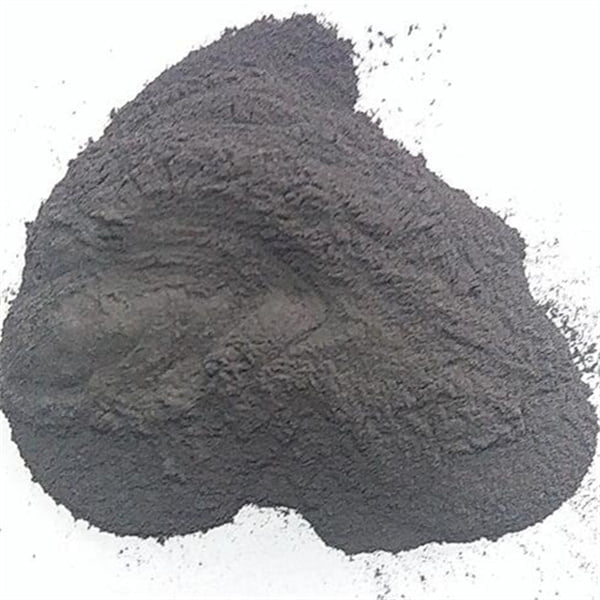
よくあるご質問
Q: 純粋な元素粉末に対する金属合金の利点は何ですか?
A: 合金は、冶金学的メカニズムと第二相制御によって、強度、耐食性、硬度、導電性などの主要な特性を、単一の元素が本来持っている限界よりも大幅に向上させることができます。
Q: 金属合金の粉末はどの程度まで小さくできますか?
A: 不活性ガスアトマイズは、現在の商業的能力の最先端で、10ナノメートル以下のナノスケールの金属粉末を生成することができます。化学的性質と形態は、新しい方法が開拓されるにつれ、激しい研究開発分野となっています。
Q: 部品製造の前に、粉体の後処理は必須ですか?
A: 正確なサイズのフラクションにふるいにかけるだけでなく、脱酸、アニール、コーティング、ブレンドなどの追加的なコンディショニングを利用することで、製造プロセスのパフォーマンス、緻密化挙動、最終的なコンポーネントの特性目標を支援する粉末特性を修正することができます。
Q: グレード間のコスト差は何によって決まるのですか?
A: 加工の複雑さ、合金元素の価格設定、研究開発投資、生産量、仕様の要求が価格設定を左右します。
結論
このガイドでは、金属合金粉末工学材料の全体的な概要を紹介し、カスタマイズされた化学と最適化された処理によって、従来の冶金的制約をはるかに超える次世代の部品性能を実現することができます。特殊グレードのユニークな利点をお客様の目標用途要件に合致させることについては、業界の専門家にご相談ください。
シェアする
MET3DP Technology Co., LTDは、中国青島に本社を置く積層造形ソリューションのリーディングプロバイダーです。弊社は3Dプリンティング装置と工業用途の高性能金属粉末を専門としています。
関連記事
Met3DPについて
最新情報
製品

3Dプリンティングと積層造形用金属粉末







